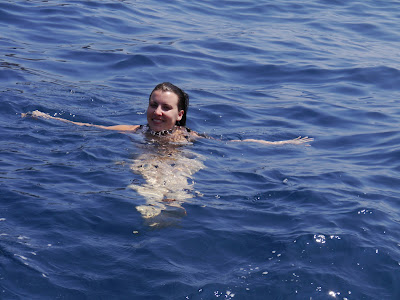 |
| Swimming at the Galli Islands...is that a Siren...? |
Homer's 'Odyssey' tells the story of Ulysses wandering trapped around the Mediterranean (or the Aegean?) for twenty years, trying fruitlessly to make his way home to the beautiful Penelope, encountering adventures and obstacles aplenty. One famous risk he ran was of being drawn upon treacherous rocks by the beguiling
songs of the Sirens. He saved himself by having his crew lash him to the mast of his ship, so that he could sail through the irresistible songs without being able to succumb.
And this is said to have happened - believe it or not - at the
Galli Islands (
'Li Galli') just off the village of
Positano on the Amalfi Coast. We know this because legends -- and Captain Patrizio of the excellent vessel
‘'O Sole Mio’, who is an incurable romantic -- tell us so. The story of the sirens at this location comes down from ‘the Latins’ for whom the word ‘
galli’ indicated a type of bird ('
gallo' is a rooster); and these Sirens were, according to this version of the legend, half-woman, half-bird (not mermaids, as some versions have it).
 |
| The Galli Islands from Positano. |
 |
| It IS a Siren! |
 |
| Small medieval chapel meets 21st century boating |
The three Galli Islands are the tips of the eroded caldera of a long-dormant underwater volcano, their sharp grey volcanic rocks fending off boat landings. To be drawn to those rocky shores would certainly have led to a dismal end for Ulysses’ ship. These days the half-circle formed between the islands, the ancient caldera, is
a marine preserve where pleasure boats can linger: swimming is allowed, but not anchoring.
 |
| Nureyev dancing on the terrace? |
 |
| Cruising near Li Galli |
Fast-forward from Greek myth through some Roman-built fortifications, and the establishment of a small monastery (a little white chapel remains) to the twentieth century, when a villa was built on the largest of the three Galli Islands. The first person to buy the islands was the Russian dancer
Leonide Massine. He built a villa with advice from his friend
Le Corbusier. It eventually became a home to
Rudolf Nureyev, who made the place a mecca for the twentieth-century jet set, and could sometimes be seen (according to Captain Patrizio) dancing on the terrace.
This blog fills out the mythical story:
"It is said that Odysseus was curious as to what the Sirens sung in their song to him, so, on Circe's advice, he had all his sailors plug their ears with beeswax and tie him to the mast. He ordered his men to leave him tied tightly to the mast, no matter how much he would beg. When he heard their beautiful song, he ordered the sailors to untie him but they bound him tighter. When they had passed out of earshot, only then was Odysseus untied."
 |
| The villa and chapel on the largest island |
Here's
Wiki's take on the
Galli Islands:
Several sirens were said to have inhabited the islands, the most famous of whom were Parthenope, Leucosia, and Ligeia. One of them played the lyre, another sang, and another played the flute. They are mentioned in the 1st century BC by Strabo, the Greek Geographer and by Straton of Sardis in 120 A.D. In ancient stories, the sirens were depicted as having bodies of a bird and human heads, but the medieval interpretations of the stories depicted them as mermaids. The terms "Sirenai" and "Sirenusai", from the Latin Sirenusae, meaning Sirens, indicate both the sirens themselves and their residence. The modern name, Li Galli or The Roosters, references the bird-like form of the ancient sirens.
 |
| The Galli Islands |
These days you can hire the villa on the Galli Islands for a stay, if you too cannot resist the Sirens’ song. Or, perhaps more practically, you can visit the divine
Hotel Sirenuse in Positano named for the Sirens and exquisitely beautiful in its own way.
 |
| View of the Islands of the Sirens from Hotel Sirenuse |










No comments:
Post a Comment